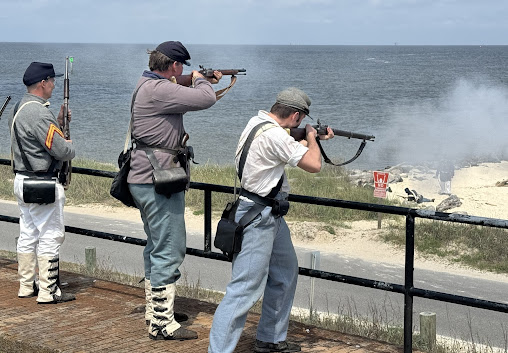 |
| Participants take a breather during Griswoldville scenario (Photo: Event volunteer Chad Carlson) |
The Old Clinton Historical Society and the 16th Georgia reenactment group
put on the fundraising event about 12 miles northeast of Macon and near the
town of Gray.
Events
included two battle reenactments – of the July 1864 Confederate cavalry victory
at Sunshine Church and the Union win at Griswoldville in November 1864, during
Sherman’s march. Both clashes occurred in Jones County.
A highlight was a Saturday evening memorial service in the Confederate cemetery
of the antebellum Methodist Church, said longtime society president
Earlene Hamilton. (Photo of reenactor by Chad Carlson)
“I think there are 29 men included,” she said. “A reenactor is positioned at each grave site with a candle-lit lantern and as the veteran’s name and unit are called, the reenactor responds, ‘Present in spirit, sir’ and then extinguishes the candle."
Over its 50 years,
the society has purchased, restored and now
maintains five of the original buildings in the Old Clinton Historic
District, three of which are antebellum. “We have secured almost 25 acres of
open land in what was originally part of antebellum Clinton. The funds we raise
from War Days all go to this ongoing mission,” Hamilton said in an email.
Sherman’s enormous 15th Corps and Federal cavalry moved through Clinton on Nov. 19-20, 1864, during the March to the Sea, inflicting damage or destroying many structures, she said.
A Georgia Civil War Heritage Trails marker said the Federal
may have been in a foul mood when they reached Clinton after finding two
unburied Union soldiers who apparently were killed at Sunshine Church nearly
four months before.
An Old Clinton marker by the trails group reads:
“Despite Clinton's depressed economy, some structures remained for the Federal troops to burn. Major Thomas Osborn, Howard's chief of artillery wrote, "Some of the men captured with General Stoneman were now with General Union Major General Kilpatrick and it was with Peter J. Osterhaus much difficulty he restrained them from burning the, [entire] town."
The Federals destroyed most of the remaining industrial and commercial buildings before advancing to Griswoldville, where they engaged Confederate militia a couple days later. By then, Union Brig. Gen. Judson Kilpatrick’s cavalry troopers had burned the Griswold and Gunnison factory that used enslaved labor to produce Confederate pistols.Hamilton told the Picket there were about 1,100 paying guests over the two days at Old Clinton, reflecting a pretty steady turnout over the past few event years. Attendance was larger in the 1980s and early 1990s.
“There are still a couple of reenactors able to come who have been involved since the first year and a good number involved in the last 35 years of the event,” she said. “I have been here for all 43 of them, plus the 50 years of the historical society. My mother was one of its founding members and considered by many as THE engine that got it started.”
The district is on the National Register of Historic Places.
The Georgia Battlefields Association mentioned "War Days" and a 2022 tour of the area in a recent newsletter.
"Earlene Hamilton provided an evocative narrative that helped us imagine the site’s appearance when Stoneman’s cavalry passed through the town twice during his July 1864 raid and when part of Sherman’s forces passed through during the March to the Sea in November. War Days provides an opportunity for visitors to have a similar experience."


















